Engine Alfa Romeo 159 2008 Owner handbook (in English)
[x] Cancel search | Manufacturer: ALFA ROMEO, Model Year: 2008, Model line: 159, Model: Alfa Romeo 159 2008Pages: 303, PDF Size: 5.18 MB
Page 216 of 303

214
SAFETY
DEVICES
WARNING
LIGHTS AND
MESSAGES
CAR
MAINTENANCE
TECHNICAL
SPECIFICATIONS
INDEX
CORRECT USE
OF THE CAR
DASHBOARD
AND
CONTROLS
IN AN
EMERGENCY
FUSE SUMMARY TABLE
LIGTHS FUSE AMPERE FIGURE
Right main beam headlight F14 10 60
Left main beam headlight F15 10 60
Right dipped beam headlight F12 15 56
Left dipped beam headlight F13 15 56
Front fog light F30 15 60
Reversing light F35 7.5 56
Third brake light F37 7.5 56
Front/rear ceiling light F39 10 56
Front ceiling light F49 7.5 56
Direction indicators F53 10 56
Hazard lights F53 10 56
USERS FUSE AMPERE FIGURE
Engine compartment control unit F70 (MEGA-FUSE) 150 58
Instrument panel control unit F71 70 58
Fuel pre-heating unit (diesel versions) F73 60 58
Boot control unit F01 (MAXI-FUSE) 70 60
Instrument panel control unit F01 (MAXI-FUSE) 70 60
Page 217 of 303
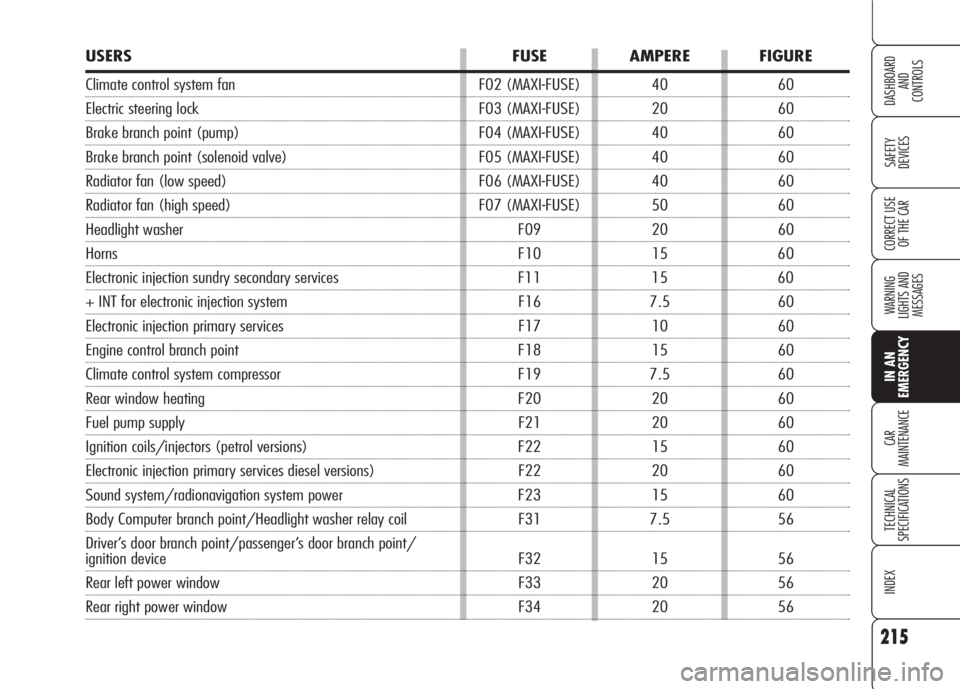
215
SAFETY
DEVICES
WARNING
LIGHTS AND
MESSAGES
CAR
MAINTENANCE
TECHNICAL
SPECIFICATIONS
INDEX
CORRECT USE
OF THE CAR
DASHBOARD
AND
CONTROLS
IN AN
EMERGENCY
USERS FUSE AMPERE FIGURE
Climate control system fan F02 (MAXI-FUSE) 40 60
Electric steering lock F03 (MAXI-FUSE) 20 60
Brake branch point (pump) F04 (MAXI-FUSE) 40 60
Brake branch point (solenoid valve) F05 (MAXI-FUSE) 40 60
Radiator fan (low speed) F06 (MAXI-FUSE) 40 60
Radiator fan (high speed) F07 (MAXI-FUSE) 50 60
Headlight washer F09 20 60
Horns F10 15 60
Electronic injection sundry secondary services F11 15 60
+ INT for electronic injection system F16 7.5 60
Electronic injection primary services F17 10 60
Engine control branch point F18 15 60
Climate control system compressor F19 7.5 60
Rear window heating F20 20 60
Fuel pump supply F21 20 60
Ignition coils/injectors (petrol versions) F22 15 60
Electronic injection primary services diesel versions) F22 20 60
Sound system/radionavigation system power F23 15 60
Body Computer branch point/Headlight washer relay coil F31 7.5 56
Driver’s door branch point/passenger’s door branch point/
ignition device F32 15 56
Rear left power window F33 20 56
Rear right power window F34 20 56
Page 224 of 303

222
SAFETY
DEVICES
WARNING
LIGHTS AND
MESSAGES
CAR
MAINTENANCE
TECHNICAL
SPECIFICATIONS
INDEX
CORRECT USE
OF THE CAR
DASHBOARD
AND
CONTROLS
IN AN
EMERGENCY
Do not start the engine
when towing the car.
WARNING
Before fitting the hook,
clean accurately its
threaded seat. Before starting
to tow, make sure to have
tighten the hook.
WARNING
Before starting to tow,
disengage the steering
lock (see paragraph “Ignition de-
vice” in section “Dashboard and
controls”). When towing, re-
member that without the help of
the brake booster and power
steering, a greater effort is re-
quired on the pedal and steer-
ing wheel. Do not use flexible ca-
bles for towing and avoid jerks.
During towing operations make
sure that fastening the joint to
the car does not damage the
components in contact with it.
When towing the car, you must
comply with the specific traffic
regulations regarding the tow
ring and how to tow on the road.
WARNING
Rear
The tow hook A-fig. 66for the rear
bumper is fixed.
A0E0176mfig. 66
❒remove the snap-fitted plug A-fig. 65
from the front bumper. If using the flat
blade screwdriver B-fig. 64 provided
as standard, protect its tip with a soft
cloth to prevent damaging the car.
❒tighten the tow hook in its seat.
A0E0230mfig. 65
Page 227 of 303
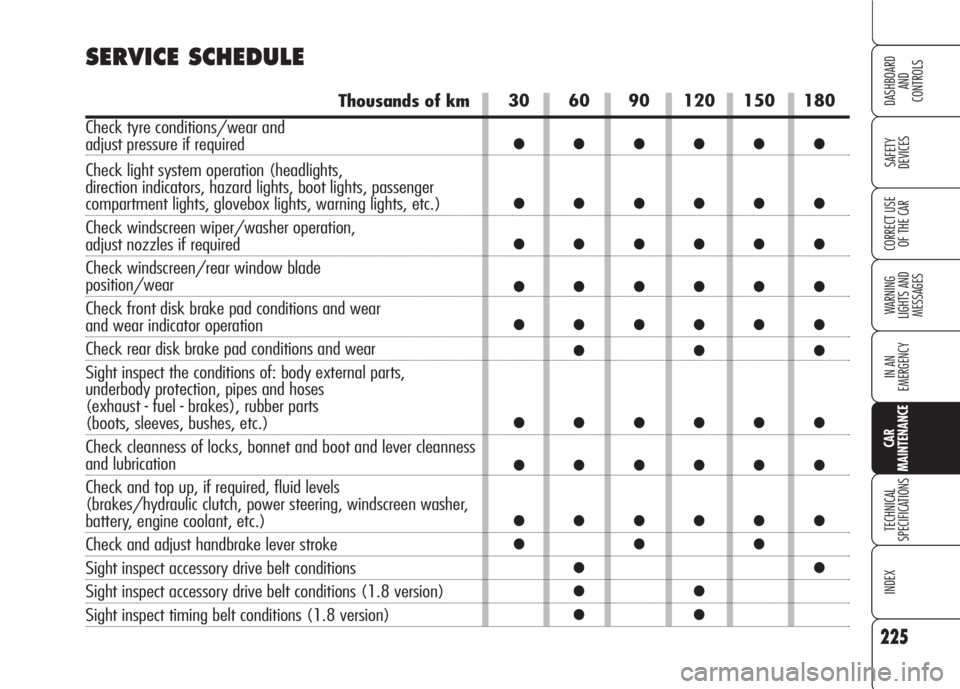
225
SAFETY
DEVICES
WARNING
LIGHTS AND
MESSAGES
IN AN
EMERGENCY
TECHNICAL
SPECIFICATIONS
INDEX
CORRECT USE
OF THE CAR
DASHBOARD
AND
CONTROLS
CAR
MAINTENANCE
30 60 90 120 150 180
●●●●●●
●●●●●●
●●●●●●
●●●●●●
●●●●●●
●●●
●●●●●●
●●●●●●
●●●●●●
●●●
●●
●●
●●
SERVICE SCHEDULE
Thousands of km
Check tyre conditions/wear and
adjust pressure if required
Check light system operation (headlights,
direction indicators, hazard lights, boot lights, passenger
compartment lights, glovebox lights, warning lights, etc.)
Check windscreen wiper/washer operation,
adjust nozzles if required
Check windscreen/rear window blade
position/wear
Check front disk brake pad conditions and wear
and wear indicator operation
Check rear disk brake pad conditions and wear
Sight inspect the conditions of: body external parts,
underbody protection, pipes and hoses
(exhaust - fuel - brakes), rubber parts
(boots, sleeves, bushes, etc.)
Check cleanness of locks, bonnet and boot and lever cleanness
and lubrication
Check and top up, if required, fluid levels
(brakes/hydraulic clutch, power steering, windscreen washer,
battery, engine coolant, etc.)
Check and adjust handbrake lever stroke
Sight inspect accessory drive belt conditions
Sight inspect accessory drive belt conditions (1.8 version)
Sight inspect timing belt conditions (1.8 version)
Page 228 of 303
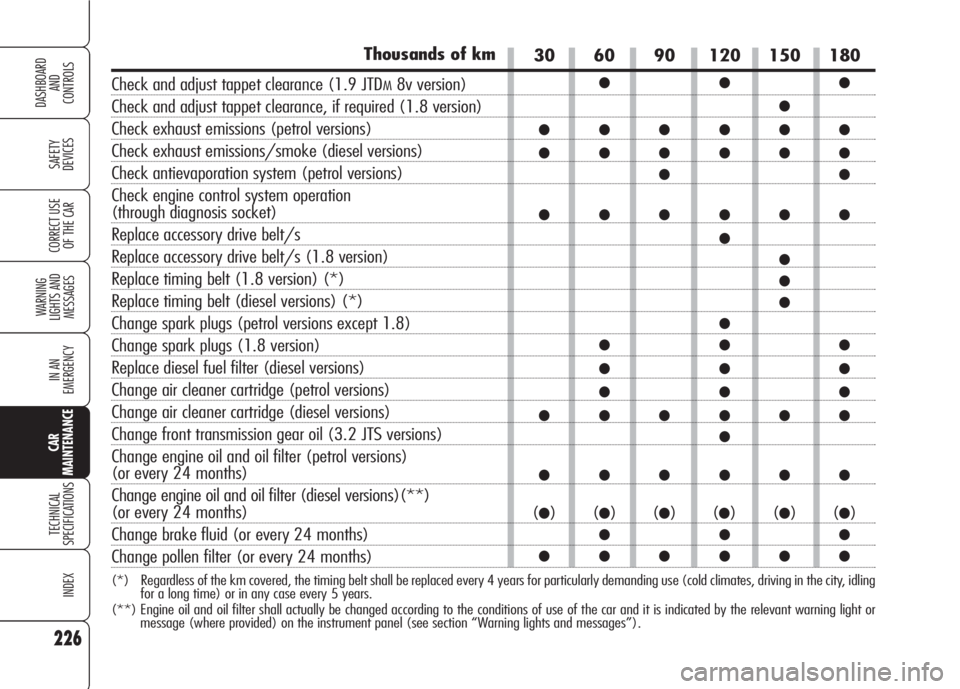
226
SAFETY
DEVICES
WARNING
LIGHTS AND
MESSAGES
IN AN
EMERGENCY
TECHNICAL
SPECIFICATIONS
INDEX
CORRECT USE
OF THE CAR
DASHBOARD
AND
CONTROLS
CAR
MAINTENANCE
Thousands of km
Check and adjust tappet clearance (1.9 JTDM8v version)
Check and adjust tappet clearance, if required (1.8 version)
Check exhaust emissions (petrol versions)
Check exhaust emissions/smoke (diesel versions)
Check antievaporation system (petrol versions)
Check engine control system operation
(through diagnosis socket)
Replace accessory drive belt/s
Replace accessory drive belt/s (1.8 version)
Replace timing belt (1.8 version) (*)
Replace timing belt (diesel versions) (*)
Change spark plugs (petrol versions except 1.8)
Change spark plugs (1.8 version)
Replace diesel fuel filter (diesel versions)
Change air cleaner cartridge (petrol versions)
Change air cleaner cartridge (diesel versions)
Change front transmission gear oil (3.2 JTS versions)
Change engine oil and oil filter (petrol versions)
(or every 24 months)
Change engine oil and oil filter (diesel versions)(**)
(or every 24 months)
Change brake fluid (or every 24 months)
Change pollen filter (or every 24 months)
(*) Regardless of the km covered, the timing belt shall be replaced every 4 years for particularly demanding use (cold climates, driving in the city, idling
for a long time) or in any case every 5 years.
(**) Engine oil and oil filter shall actually be changed according to the conditions of use of the car and it is indicated by the relevant warning light or
message (where provided) on the instrument panel (see section “Warning lights and messages”).
30 60 90 120 150 180
●●●
●
●●●●●●
●●●●●●
●●
●●●●●●
●
●
●
●
●
●●●
●●●
●●●
●●●●●●
●
●●●●●●
(●)(●)(●)(●)(●)(●)
●●●
●●●●●●
Page 229 of 303
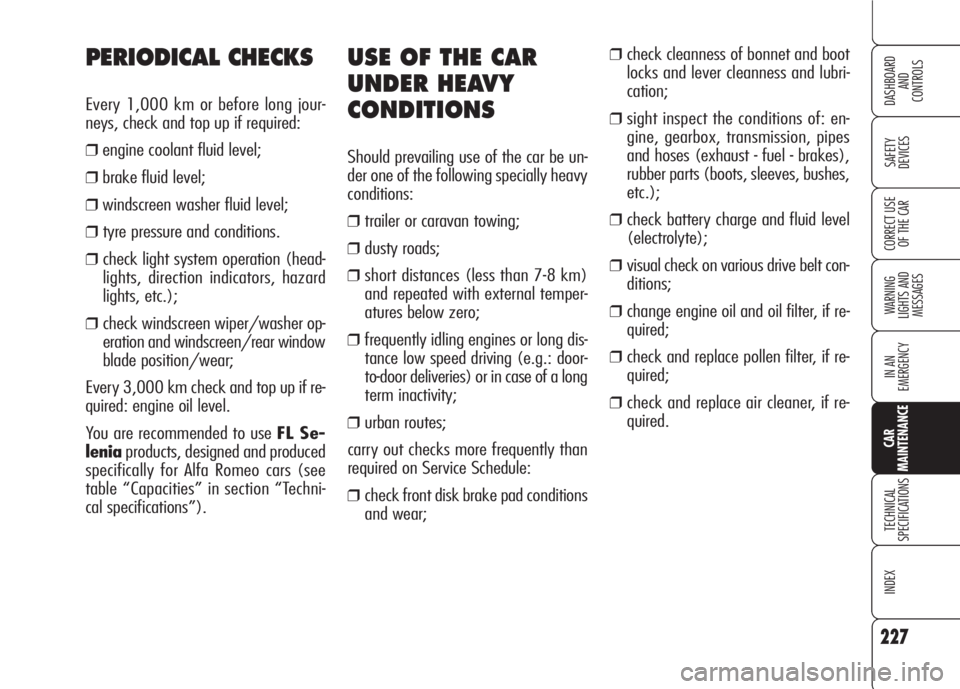
227
SAFETY
DEVICES
WARNING
LIGHTS AND
MESSAGES
IN AN
EMERGENCY
TECHNICAL
SPECIFICATIONS
INDEX
CORRECT USE
OF THE CAR
DASHBOARD
AND
CONTROLS
CAR
MAINTENANCE
USE OF THE CAR
UNDER HEAVY
CONDITIONS
Should prevailing use of the car be un-
der one of the following specially heavy
conditions:
❒ trailer or caravan towing;
❒ dusty roads;
❒ short distances (less than 7-8 km)
and repeated with external temper-
atures below zero;
❒ frequently idling engines or long dis-
tance low speed driving (e.g.: door-
to-door deliveries) or in case of a long
term inactivity;
❒ urban routes;
carry out checks more frequently than
required on Service Schedule:
❒ check front disk brake pad conditions
and wear;
❒ check cleanness of bonnet and boot
locks and lever cleanness and lubri-
cation;
❒ sight inspect the conditions of: en-
gine, gearbox, transmission, pipes
and hoses (exhaust - fuel - brakes),
rubber parts (boots, sleeves, bushes,
etc.);
❒ check battery charge and fluid level
(electrolyte);
❒ visual check on various drive belt con-
ditions;
❒ change engine oil and oil filter, if re-
quired;
❒ check and replace pollen filter, if re-
quired;
❒ check and replace air cleaner, if re-
quired.
PERIODICAL CHECKS
Every 1,000 km or before long jour-
neys, check and top up if required:
❒engine coolant fluid level;
❒brake fluid level;
❒windscreen washer fluid level;
❒ tyre pressure and conditions.
❒ check light system operation (head-
lights, direction indicators, hazard
lights, etc.);
❒ check windscreen wiper/washer op-
eration and windscreen/rear window
blade position/wear;
Every 3,000 km check and top up if re-
quired: engine oil level.
You are recommended to use FL Se-
leniaproducts, designed and produced
specifically for Alfa Romeo cars (see
table “Capacities” in section “Techni-
cal specifications”).
Page 230 of 303
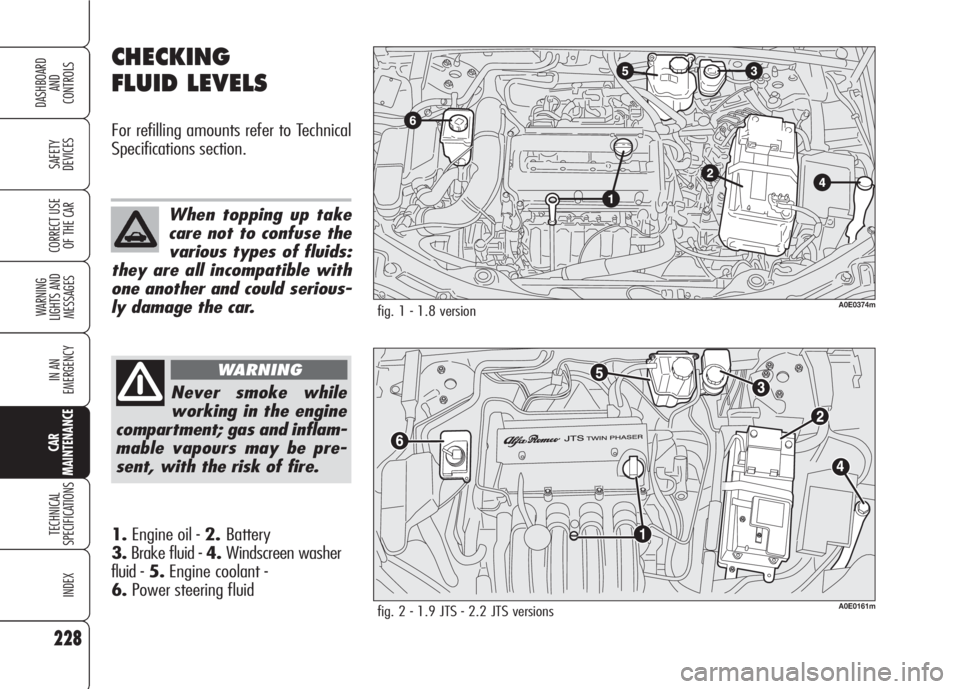
228
SAFETY
DEVICES
WARNING
LIGHTS AND
MESSAGES
IN AN
EMERGENCY
TECHNICAL
SPECIFICATIONS
INDEX
CORRECT USE
OF THE CAR
DASHBOARD
AND
CONTROLS
CAR
MAINTENANCE
CHECKING
FLUID LEVELS
For refilling amounts refer to Technical
Specifications section.
1.Engine oil - 2.Battery
3.Brake fluid - 4.Windscreen washer
fluid - 5.Engine coolant -
6.Power steering fluid
fig. 2 - 1.9 JTS - 2.2 JTS versionsA0E0161m
Never smoke while
working in the engine
compartment; gas and inflam-
mable vapours may be pre-
sent, with the risk of fire.
WARNING
When topping up take
care not to confuse the
various types of fluids:
they are all incompatible with
one another and could serious-
ly damage the car.
A0E0374mfig. 1 - 1.8 version
Page 231 of 303
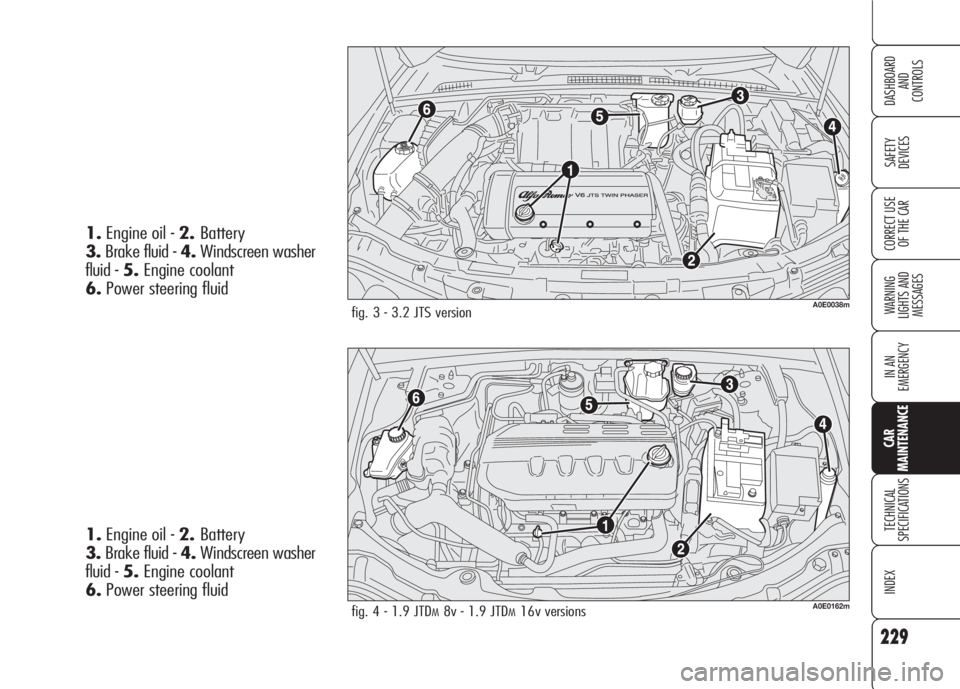
229
SAFETY
DEVICES
WARNING
LIGHTS AND
MESSAGES
IN AN
EMERGENCY
TECHNICAL
SPECIFICATIONS
INDEX
CORRECT USE
OF THE CAR
DASHBOARD
AND
CONTROLS
CAR
MAINTENANCE
fig. 3 - 3.2 JTS versionA0E0038m
fig. 4 - 1.9 JTDM8v - 1.9 JTDM16v versionsA0E0162m
1.Engine oil - 2.Battery
3.Brake fluid - 4.Windscreen washer
fluid - 5.Engine coolant
6.Power steering fluid 1.Engine oil - 2.Battery
3.Brake fluid - 4.Windscreen washer
fluid - 5.Engine coolant
6.Power steering fluid
Page 232 of 303

230
SAFETY
DEVICES
WARNING
LIGHTS AND
MESSAGES
IN AN
EMERGENCY
TECHNICAL
SPECIFICATIONS
INDEX
CORRECT USE
OF THE CAR
DASHBOARD
AND
CONTROLS
CAR
MAINTENANCE
fig. 5 - 2.4 JTDMversionA0E0203m
1.Engine oil - 2.Battery
3.Brake fluid - 4.Windscreen washer
fluid - 5.Engine coolant
6.Power steering fluid
Page 233 of 303

231
SAFETY
DEVICES
WARNING
LIGHTS AND
MESSAGES
IN AN
EMERGENCY
TECHNICAL
SPECIFICATIONS
INDEX
CORRECT USE
OF THE CAR
DASHBOARD
AND
CONTROLS
CAR
MAINTENANCEENGINE OIL
Fig. 6: 1.8 version
Fig. 7: 1.9 JTS - 2.2 JTS versions
Fig. 8: 3.2 JTS version
Fig. 9: 1.9 JTD
M8V-
1.9 JTD
M16Vversions
Fig. 10: 2.4 JTD
MversionChecking engine oil
Check the oil level a few minutes (about
5) after the engine has stopped, with
the car parked on level ground.
Remove the dipstick Aand clean it, put it
back in completely, remove it and check
that the level is within the MINand
MAXmarks on the dipstick. The gap be-
tween the MINandMAXmarks cor-
responds to about one litre of oil.
A0E0018mfig. 7
A0E0069mfig. 8
A0E0233mfig. 9
A0E0202mfig. 10A0E0400mfig. 6